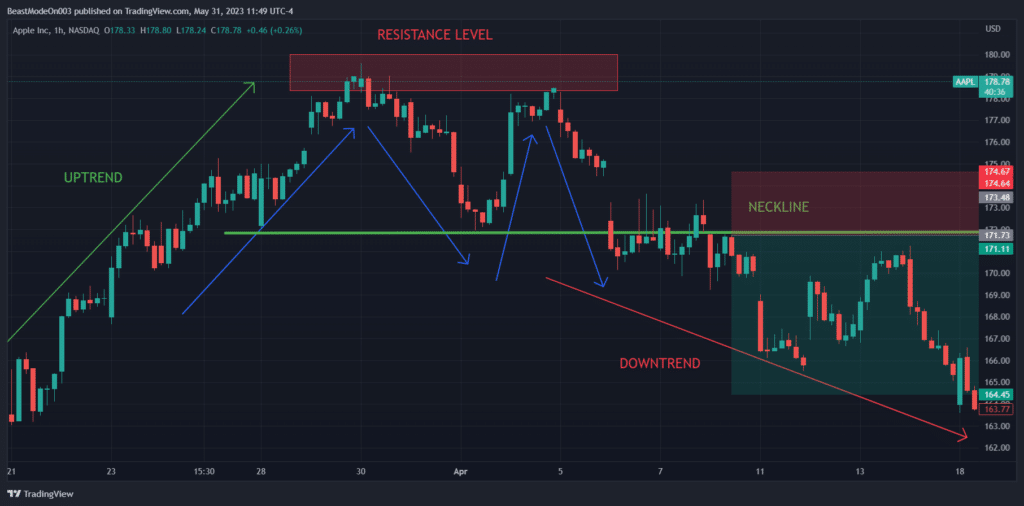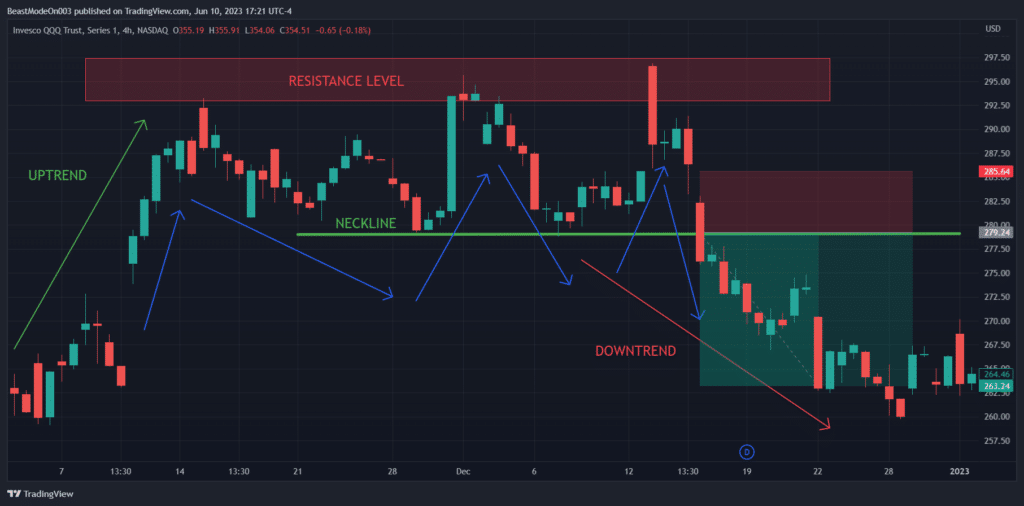Understanding and recognizing chart patterns is a valuable skill for traders and investors. In this article, we will offer detailed explanations and insightful analyses of the widely encountered and commonly used patterns. By the end of this article, you will possess the ability to effortlessly recognize and comprehend the significance and interpretation of each of these patterns. Moreover, we will show you dependable and remarkably precise trading strategies for every one of these patterns. The chart patterns we will explore in this article include double top, double bottom, triple top, and triple bottom, (we will explore head and shoulders, and inverse head and shoulders in the part 3).
Double top:
This is what a double top looks like in a chart:

A double top always starts with an uptrend movement then the price makes a swing low forming a first high, after this, the price goes back up with a swing high followed by another swing low, forming the second high at the same level as the first high.
the two tops form a resistance level (also called resistance zone) represented in the picture by a red zone. the swing high creates a support level called the neckline represented in the picture by a green line.
Interpretation of a Double Top:
A double top means that the price failed to make a higher high and instead made the same high, indicating that there is a loss of momentum from the buyers and a gain of momentum from the sellers, resulting in the loss of momentum in the uptrend movement and a gain of momentum in the downtrend movement. This suggests that the uptrend movement might convert into a downtrend movement resulting in a trend reversal.
Double Top trading strategy:
Once you have spotted a double-top pattern, draw your resistance level and neckline, then wait and see how the market is going to perform, two potential scenarios could happen:
First scenario: The price breaks below the neckline and makes a lower low, which confirms that the trend reversal is happening. at this point, you would take a short position and place your stop loss and take profit as shown in the picture above. We used a 1:2.5 risk/reward ratio in this trade which is considered a fairly low risk/reward ratio.
Second scenario: The price does not break below the neckline and bounces back up, which confirms that the market is not likely to perform a trend reversal, it’s recommended not to trade in such market conditions, the best move in these cases is to wait until you see another opportunity.
Double bottom:
This is what a double bottom looks like in a chart:

A double bottom always starts with a downtrend movement then the price makes a swing high forming a first low, after this, the price goes back down with a swing low followed by another swing high, forming the second low at the same level as the first low.
the two bottoms form a support level represented in the picture by a green zone. the swing low creates a resistance level called the neckline represented in the picture by a green line.
Interpretation of a Double Bottom:
A double bottom means that the price failed to make a lower low and instead made the same low, indicating that there is a loss of momentum from the sellers and a gain of momentum from the buyers, resulting in the loss of momentum in the downtrend movement and a gain of momentum in the uptrend movement. This suggests that the downtrend movement might convert into an uptrend movement resulting in a trend reversal.
Double Bottom trading strategy:
Once you have spotted a double-bottom pattern, draw your support level and neckline, then wait and see how the market is going to perform, two potential scenarios could happen:
First scenario: The price breaks above the neckline and makes a higher high, which confirms that the trend reversal is happening. at this point, you would take a long position, place your stop loss, and take profit, as shown in the picture above. We used a 1:2 risk/reward ratio in this trade.
Second scenario: The price does not break above the neckline and bounces back down, which confirms that the market is not likely to perform a trend reversal, it’s recommended not to trade in such market conditions, the best move in these cases is to wait until you see another opportunity.
Triple top:
This is what a triple top looks like in a chart:

A triple top always starts with an uptrend movement then the price makes three same highs in a row forming the triple top pattern. The three tops form a resistance level represented in the picture by a red zone. the two swing highs create the neckline (support level) represented in the picture by a green line.
Interpretation of a Triple Top:
A triple top pattern occurs when the price attempts to make a higher high but instead forms three equal highs. This indicates a loss of momentum from the buyers and a gain of momentum from the sellers, leading to a weakening of the uptrend movement and a strengthening of the downtrend movement. This pattern suggests a potential reversal from an uptrend to a downtrend.
Triple Top trading strategy:
Once you have identified a triple-top pattern, draw the resistance level and neckline on your chart, then patiently observe how the market performs, as two potential scenarios may arise:
First scenario: The price breaches below the neckline, establishing a lower low and validating the trend reversal. In this case, it is appropriate to initiate a short position, set your stop loss, and define a take-profit level, as represented in the accompanying illustration. We employed a 1:2.5 risk/reward ratio in the trade shown above.
Second scenario: The price fails to break below the neckline and instead bounces back up, indicating that a trend reversal is unlikely. During such market conditions, it is advisable to refrain from trading. It is wise to wait for another opportunity to arise before taking any further action.
Triple bottom:
This is what a triple bottom looks like in a chart:

A triple bottom always starts with a downtrend movement then the price makes three same lows in a row forming the triple bottom pattern. The three bottoms form a support level represented in the picture by a green zone. the two swing lows create the neckline (resistant level) represented in the picture by a green line.
Interpretation of a Triple Bottom:
A triple bottom pattern emerges when the price tries to establish a lower low but instead creates three identical lows. This signifies a decline in selling momentum and an increase in buying momentum, resulting in a downtrend weakening and an uptrend strengthening. The pattern implies a possible shift from a downtrend to an uptrend, indicating a potential trend reversal.
Triple Bottom trading strategy:
Once you have identified a triple-bottom pattern, plot the support level and neckline on your chart, and patiently observe the market’s performance, as two possible scenarios may unfold:
First scenario: The price surpasses the neckline, achieving a higher high and confirming the trend reversal. In this situation, it is suitable to enter a long position, set a stop loss, and determine a take-profit level, as depicted in the accompanying illustration. We utilized a 1:2 risk/reward ratio in the trade example above.
Second scenario: The price fails to break above the neckline and instead retraces downwards, indicating an unlikely trend reversal. During such market conditions. The best move in this situation is to wait for another opportunity.
Author
Hi, I’m Amine! My mission is to make finance accessible and fun for everyone. I love breaking down things that seem difficult into simple, easy, and useful tips that help you make good decisions. My aim is to ensure your experience on our blog is informative and fun.
View all posts



